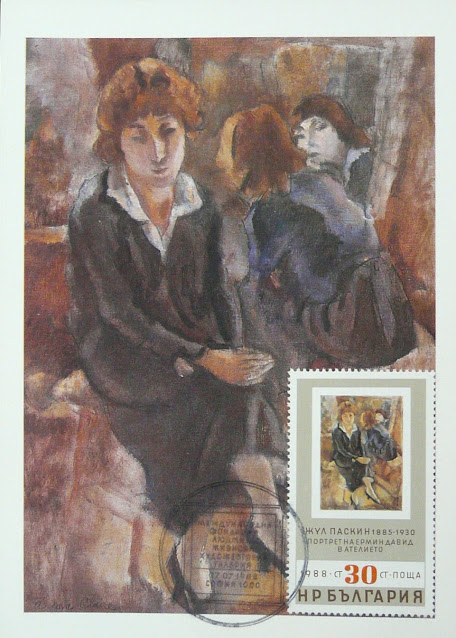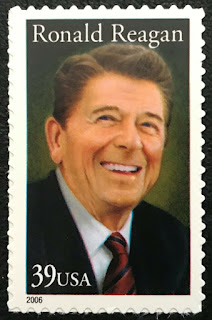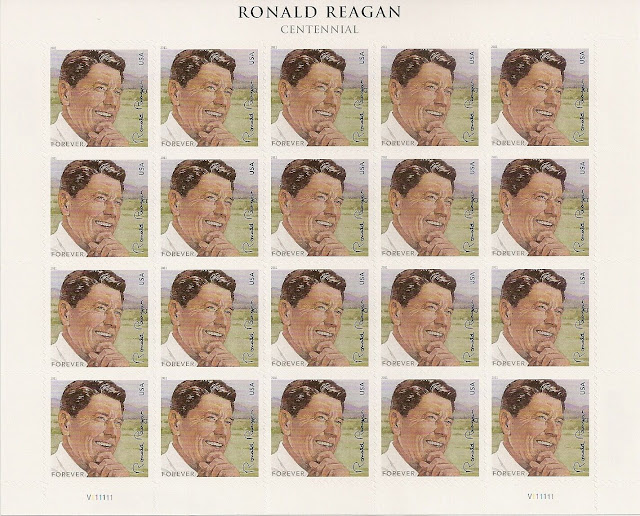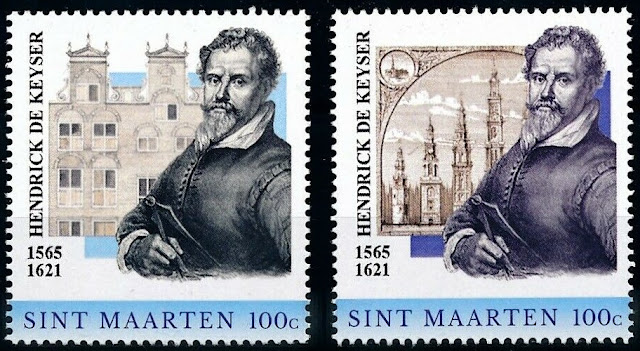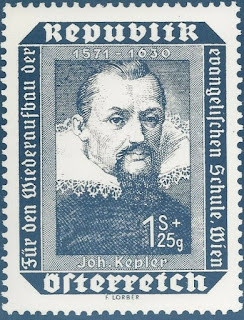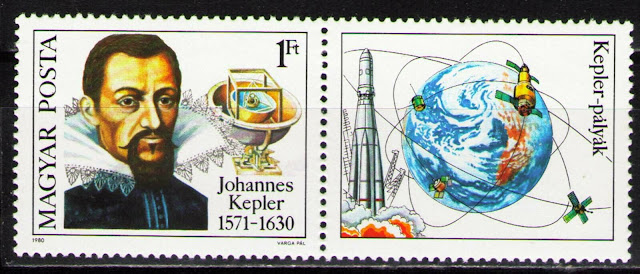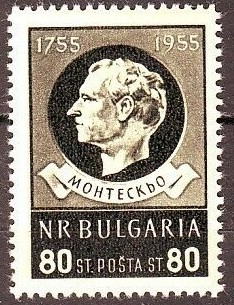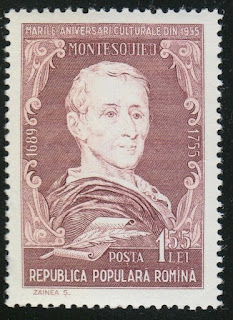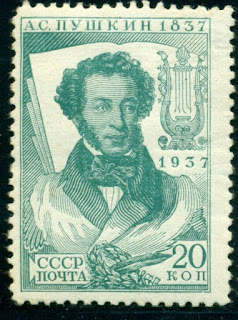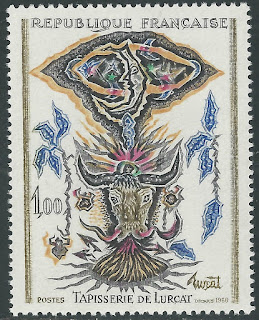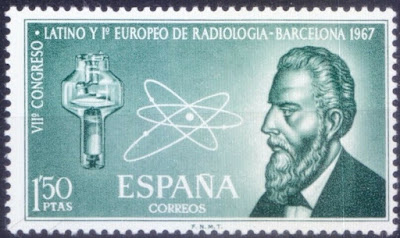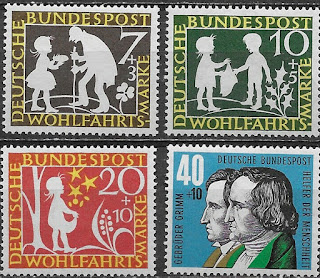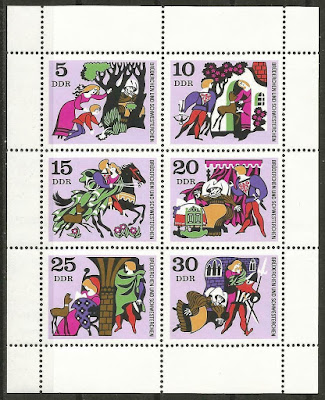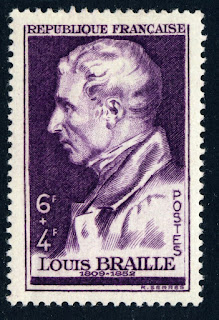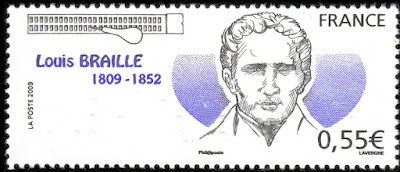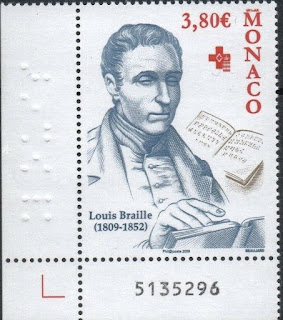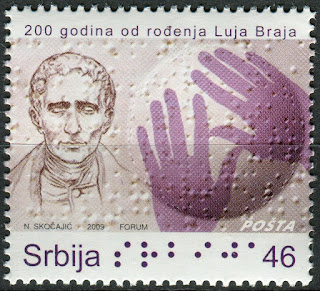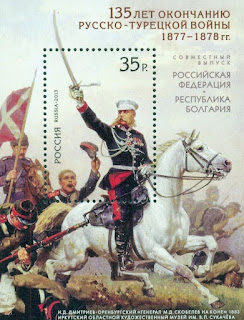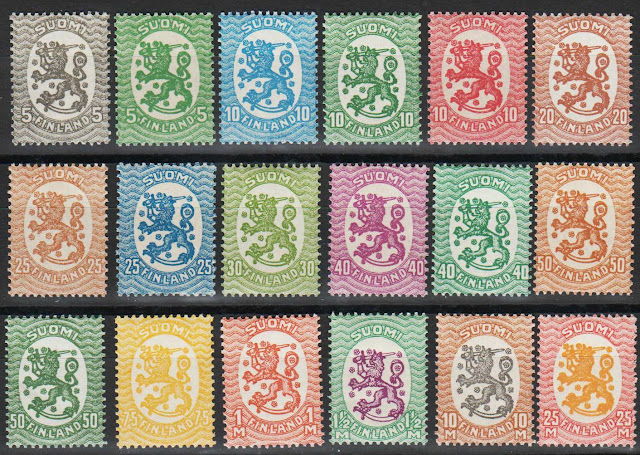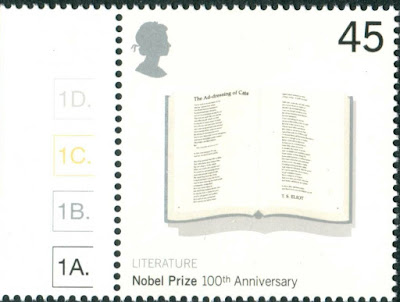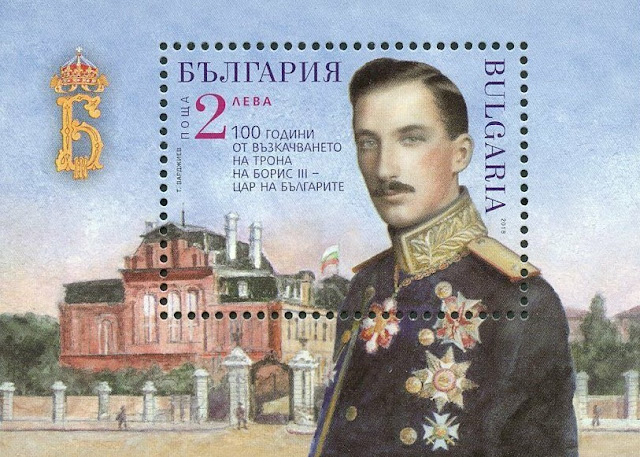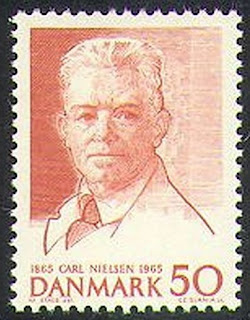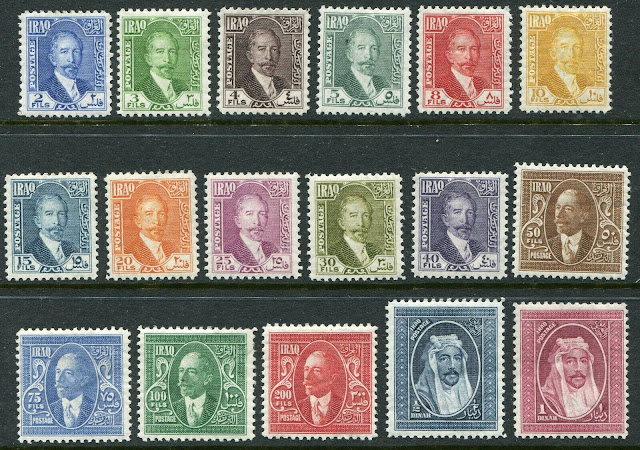Friday, June 05, 2020
June 5th in stamps Carl Maria von Weber, Pascin, Ronald Reagan
1826 Died: Carl Maria von Weber, German pianist, composer, and conductor (b. 1786)
Carl Maria Friedrich Ernst von Weber (18 or 19 November 1786 – 5 June 1826) was a German composer, conductor, pianist, guitarist and critic, and was one of the first significant composers of the Romantic school.
Weber's operas Der Freischütz, Euryanthe and Oberon greatly influenced the development of the Romantische Oper (Romantic opera) in Germany. Der Freischütz came to be regarded as the first German national opera, Euryanthe developed the Leitmotif technique to an unprecedented degree, while Oberon may have influenced Mendelssohn's music for A Midsummer Night's Dream and, at the same time, revealed Weber's lifelong interest in the music of non-Western cultures. This interest was first manifested in Weber's incidental music for Schiller's translation of Gozzi's Turandot, for which he used a Chinese melody, making him the first Western composer to use an Asian tune that was not of the pseudo-Turkish kind popularized by Mozart and others.
Weber's compositions for clarinet, bassoon, and horn occupy an important place in the musical repertoire. His compositions for the clarinet, which include two concertos, a concertino, a quintet, a duo concertante, and variations on a theme from his opera Silvana, are regularly performed today. His Concertino for Horn and Orchestra requires the performer to simultaneously produce two notes by humming while playing—a technique known as "multiphonics". His bassoon concerto and the Andante e Rondo ungarese (a reworking of a piece originally for viola and orchestra) are also popular with bassoonists.
Weber's contribution to vocal and choral music is also significant. His body of Catholic religious music was highly popular in 19th-century Germany, and he composed one of the earliest song cycles, Die Temperamente beim Verluste der Geliebten (Temperaments on the Loss of a Lover). Weber was also notable as one of the first conductors to conduct without a piano or violin.
Weber's orchestration has also been highly praised and emulated by later generations of composers – Berlioz referred to him several times in his Treatise on Instrumentation while Debussy remarked that the sound of the Weber orchestra was obtained through the scrutiny of the soul of each instrument.
His operas influenced the work of later opera composers, especially in Germany, such as Marschner, Meyerbeer and Wagner, as well as several nationalist 19th-century composers such as Glinka. Homage has been paid to Weber by 20th-century composers such as Debussy, Stravinsky, Mahler (who completed Weber's unfinished comic opera Die drei Pintos and made revisions of Euryanthe and Oberon) and Hindemith (composer of the popular Symphonic Metamorphosis of Themes by Carl Maria von Weber, based on lesser-known keyboard works and the incidental music to Turandot).
Weber also wrote music journalism and was interested in folksong, and learned lithography to engrave his own works.
East and West German stamps depicting Weber
1930 Died: Pascin, Bulgarian-French painter and illustrator (b. 1885)
Julius Mordecai Pincas (March 31, 1885 – June 5, 1930), known as Pascin, Jules Pascin, or the "Prince of Montparnasse", was a Bulgarian artist known for his paintings and drawings. He later became an American citizen. His most frequent subject was women, depicted in casual poses, usually nude or partly dressed.
Pascin was educated in Vienna and Munich. He traveled for a time in the United States, spending most of his time in the South. He is best known as a Parisian painter, who associated with the artistic circles of Montparnasse, and was one of the emigres of the School of Paris. Having struggled with depression and alcoholism, he committed suicide at the age of 45.
Bulgarian maximum card featuring Jules Pascin's portrait of his wife
2004 Died: Ronald Reagan, American actor and politician, 40th President of the United States (b. 1911)
Ronald Wilson Reagan (February 6, 1911 – June 5, 2004) was an American politician who served as the 40th president of the United States from 1981 to 1989 and became a highly influential voice of modern conservatism. Prior to his presidency, he was a Hollywood actor and union leader before serving as the 33rd governor of California from 1967 to 1975.
Reagan was elected governor of California in 1966. As governor, Reagan raised taxes, turned a state budget deficit to a surplus, challenged the protesters at the University of California, ordered in National Guard troops during a period of protest movements in 1969, and was re-elected in 1970. He twice ran unsuccessfully for the Republican presidential nomination, in 1968 and 1976.
In 1980, Reagan won the Republican presidential nomination and defeated the incumbent president, Jimmy Carter. At 69 years, 349 days of age at the time of his first inauguration, Reagan was the oldest person to assume the U.S. presidency, a distinction he held until 2017, when Donald Trump was inaugurated at age 70 years, 220 days. Reagan faced former vice president Walter Mondale when he ran for re-election in 1984 and defeated him, winning the most electoral votes of any U.S. president, 525, or 97.6% of the 538 votes in the Electoral College. It was the second-most lopsided presidential election in modern U.S. history after Franklin D. Roosevelt's 1936 victory over Alfred M. Landon, in which he won 98.5%, or 523, of the (then-total) 531 electoral votes.
Soon after taking office as president, Reagan began implementing sweeping new political and economic initiatives. His supply-side economic policies, dubbed "Reaganomics", advocated tax rate reduction to spur economic growth, economic deregulation, and reduction in government spending. In his first term, he survived an assassination attempt, spurred the War on Drugs, invaded Grenada, and fought public sector labor unions. Over his two terms, the economy saw a reduction of inflation from 12.5% to 4.4% and an average real GDP annual growth of 3.4%. Reagan enacted cuts in domestic discretionary spending, cut taxes, and increased military spending, which contributed to increased federal debt overall. Foreign affairs dominated his second term, including the bombing of Libya, the Iran–Iraq War, the Iran–Contra affair, and the ongoing Cold War. In June 1987, four years after he publicly described the Soviet Union as an "evil empire", Reagan challenged Soviet General Secretary Mikhail Gorbachev to "tear down this wall!", during a speech at the Brandenburg Gate. He transitioned Cold War policy from détente to rollback by escalating an arms race with the USSR while engaging in talks with Gorbachev. The talks culminated in the INF Treaty, which shrank both countries' nuclear arsenals. Reagan began his presidency during the decline of the Soviet Union, which ultimately collapsed nearly three years after he left office.
When Reagan left office in 1989, he held an approval rating of 68%, matching those of Franklin D. Roosevelt, and later Bill Clinton, as the highest ratings for departing presidents in the modern era. He was the first president since Dwight D. Eisenhower to serve two full terms after the five prior presidents did not. Although he had planned an active post-presidency, Reagan disclosed in November 1994 that he had been diagnosed with Alzheimer's disease earlier that year. Afterward, his informal public appearances became more infrequent as the disease progressed. He died at home on June 5, 2004. His tenure constituted a realignment toward conservative policies in the United States, and he is an icon among conservatives. Evaluations of his presidency among historians and the general public place him among the upper tier of American presidents.
US Stamps depicting Reagan
Friday, May 15, 2020
May 15th in stamps de Keyser, third law of planetary motion, Pierre Curie
1565 Born: Hendrick de Keyser, Dutch sculptor and architect born in Utrecht (d. 1621)
Hendrick de Keyser (15 May 1565 – 15 May 1621) was a Dutch sculptor and architect born in Utrecht, Netherlands, who was instrumental in establishing a late Renaissance form of Mannerism in Amsterdam. He was the father of Thomas de Keyser who was an architect and portrait painter.
De Keyser is famous for a number of important buildings which belong to the core of Dutch historic sites. Today the Zuiderkerk (1603-1611) and accompanying tower (1614), the Delft Town Hall (1618-1620), the Westerkerk (1620-1631) and Westertoren (built in 1638 but in a modified version) are among the historic buildings which provide important insights into De Keyser's work. His Commodity Exchange of 1608-1613 was pulled down in the 19th century.
Hendrick de Keyser's projects in Amsterdam during the early decades of the 17th century helped establish a late Mannerist style referred to as "Amsterdam Renaissance". The Amsterdam Renaissance style deviates in many respects from sixteenth-century Italian Renaissance architecture. Classical elements such as pilasters, cornices and frontons were used on a large scale, but mainly as decorative elements. De Keyser never slavishly followed the tenets of classical architecture as laid down in the Italian treatises. His version came to full bloom at the end of the second decade of the 17th century, and set the stage for the later Dutch classical phase of Jacob van Campen and Pieter Post. The East India House in Amsterdam was most likely also designed by him.
Stamps Issued by Sint Maarten commemorating Hendrick de Keyser
1618 – Johannes Kepler confirms his previously rejected discovery of the third law of planetary motion
Kepler's laws of planetary motion are three scientific laws describing the motion of planets around the Sun, published by Johannes Kepler between 1609 and 1619. These improved the heliocentric theory of Nicolaus Copernicus, replacing its circular orbits and epicycles with elliptical trajectories, and explaining how planetary velocities vary. The laws state that:
- The orbit of a planet is an ellipse with the Sun at one of the two foci.
- A line segment joining a planet and the Sun sweeps out equal areas during equal intervals of time.
- The square of the orbital period of a planet is directly proportional to the cube of the semi-major axis of its orbit.
The elliptical orbits of planets were indicated by calculations of the orbit of Mars. From this, Kepler inferred that other bodies in the Solar System, including those farther away from the Sun, also have elliptical orbits. The second law helps to establish that when a planet is closer to the Sun, it travels faster. The third law expresses that the farther a planet is from the Sun, the longer its orbit, and vice versa.
1859 Born: Pierre Curie, French physicist and academic, Nobel Prize laureate (d. 1906)
Pierre Curie (15 May 1859 – 19 April 1906) was a French physicist, a pioneer in crystallography, magnetism, piezoelectricity, and radioactivity. In 1903, he received the Nobel Prize in Physics with his wife, Marie Skłodowska-Curie, and Henri Becquerel, "in recognition of the extraordinary services they have rendered by their joint researches on the radiation phenomena discovered by Professor Henri Becquerel".
French stamp depicting Pierre and Marie Curie
Monday, February 10, 2020
February 10th in stamps Montesquieu, Pushkin, Daumier, Röntgen, David Thompson
1755 Died: Montesquieu, French lawyer and philosopher (b. 1689)
Charles-Louis de Secondat, Baron de La Brède et de Montesquieu (18 January 1689 – 10 February 1755), generally referred to as simply Montesquieu, was a French judge, man of letters, and political philosopher.
He is the principal source of the theory of separation of powers, which is implemented in many constitutions throughout the world. He is also known for doing more than any other author to secure the place of the word "despotism" in the political lexicon. His anonymously-published The Spirit of Law in 1748, which was received well in both Great Britain and the American colonies, influenced the Founding Fathers in drafting the United States Constitution.
Stamps from Bulgaria, France and Romania commemorating Montesquieu
1837 Died: Alexander Pushkin, Russian poet and author (b. 1799)
Alexander Sergeyevich Pushkin (6 June 1799 – 10 February 1837) was a Russian poet, playwright, and novelist of the Romantic era who is considered by many to be the greatest Russian poet and the founder of modern Russian literature.
Pushkin was born into Russian nobility in Moscow. His father, Sergey Lvovich Pushkin, belonged to Pushkin noble families. His maternal great-grandfather was African-born general Abram Petrovich Gannibal. He published his first poem at the age of 15, and was widely recognized by the literary establishment by the time of his graduation from the Tsarskoye Selo Lyceum. Upon graduation from the Lycee, Pushkin recited his controversial poem "Ode to Liberty", one of several that led to his exile by Tsar Alexander I of Russia. While under the strict surveillance of the Tsar's political police and unable to publish, Pushkin wrote his most famous play, the drama Boris Godunov. His novel in verse, Eugene Onegin, was serialized between 1825 and 1832.
Pushkin was fatally wounded in a duel with his brother-in-law, Georges-Charles de Heeckeren d'Anthès, also known as Dantes-Gekkern, a French officer serving with the Chevalier Guard Regiment, who attempted to seduce the poet's wife, Natalia Pushkina.
1770 Born: David Thompson, English-Canadian cartographer and explorer (d. 1857)
David Thompson (30 April 1770 – 10 February 1857) was a British-Canadian fur trader, surveyor, and cartographer, known to some native peoples as Koo-Koo-Sint or "the Stargazer". Over Thompson's career, he traveled some 90,000 kilometers (56,000 mi) across North America, mapping 4.9 million square kilometers (1.9 million square miles) of North America along the way. For this historic feat, Thompson has been described as the "greatest practical land geographer that the world has produced".
Canadian stamp issued to commemorate David Thompson
1879 Died: Honoré Daumier, French illustrator and painter (b. 1808)
Honoré-Victorin Daumier (February 26, 1808 – February 10, 1879) was a French printmaker, caricaturist, painter, and sculptor, whose many works offer commentary on social and political life in France in the 19th century.
Daumier produced more than 500 paintings, 4000 lithographs, 1000 wood engravings, 1000 drawings and 100 sculptures. A prolific draughtsman, he was perhaps best known for his caricatures of political figures and satires on the behavior of his countrymen, although posthumously the value of his painting has also been recognized.
Daumier's works are found in many of the world's leading art museums, including the Louvre, the Metropolitan Museum of Art and the Rijksmuseum. He is celebrated for a range of works, including a large number of paintings (500) and drawings (1000) some of them depicting the life of Don Quijote, a theme that fascinated him for the last part of his life.
Daumier's 200th birthday was celebrated in 2008 with a number of exhibitions in Asia, America, Australia and Europe.
1923 Died: Wilhelm Röntgen, German physicist and academic, Nobel Prize laureate (b. 1845)
Wilhelm Conrad Röntgen (27 March 1845 – 10 February 1923) was a German mechanical engineer and physicist, who, on 8 November 1895, produced and detected electromagnetic radiation in a wavelength range known as X-rays or Röntgen rays, an achievement that earned him the first Nobel Prize in Physics in 1901. In honour of his accomplishments, in 2004 the International Union of Pure and Applied Chemistry (IUPAC) named element 111, roentgenium, a radioactive element with multiple unstable isotopes, after him.
Today, in Remscheid-Lennep, 40 kilometers east of Düsseldorf, the town in which Röntgen was born in 1845 is the Deutsches Röntgen-Museum.
In Würzburg, where he discovered the X-rays, a non-profit organization maintains his laboratory and provides guided tours to the Röntgen Memorial Site.
World Radiology Day: The International Day of Radiology is an annual event promoting the role of medical imaging in modern healthcare. It is celebrated on 8 November each year, coincides with the anniversary of the discovery of X-rays by Wilhelm Roentgen in 1895. It was first introduced in 2012, as a joint initiative, by the European Society of Radiology (ESR), the Radiological Society of North America (RSNA), and the American College of Radiology (ACR).
Röntgen Peak in Antarctica is named after Wilhelm Röntgen
Stamps from India, Germany and Spain depicting Wilhelm Röntgen
Saturday, January 04, 2020
January 4th in stamps Russo-Turkish War Liberated Bulgaria, Finnish Declaration of Independence recognized, Grimms Fairy Tales, T. S. Eliot
1785 Born: Jacob Grimm, German philologist and mythologist (d. 1863)
Jacob Ludwig Karl Grimm (4 January 1785 – 20 September 1863), also known as Ludwig Karl, was a German philologist, jurist, and mythologist. He is known as the discoverer of Grimm's law of linguistics, the co-author of the monumental Deutsches Wörterbuch, the author of Deutsche Mythologie, and the editor of Grimm's Fairy Tales. He was the elder of the Brothers Grimm.
A collection of fairy tales was first published in 1812 by the Grimm brothers, known in English as Grimms' Fairy Tales.
From 1837–1841, the Grimm brothers joined five of their colleague professors at the University of Göttingen to form a group known as the Göttinger Sieben (The Göttingen Seven). They protested against Ernest Augustus, King of Hanover, whom they accused of violating the constitution. All seven were fired by the king.
Stamps from Germany, East Germany and Berlin featuring the Grimm brothers or their fairy tales
1809 Born: Louis Braille, French educator, invented Braille (d. 1852)
Stamps from France, Monaco, East Germany, Vatican, Serbia and Montenegro depicting Louis Braille
1878 – Russo-Turkish War (1877–78): Sofia is liberated from Ottoman rule and designated the capital of Liberated Bulgaria.
The Battle of Sofia (Bulgarian: Битката при София) was the culmination of Russian General Iosif Gurko's Western Squad for the defeat of the Orkhanie army in the Russo-Turkish War (1877-1878). It led to the Liberation of Sofia from Turkish rule.
The forces of the West group Gurko attacked in total offensive on 22 December / January 3. Column Lieutenant Velyaminov captured Kubratovo and Birimirtsi villages and went to Orlandovtsi village. The column of Major General Rauch captured the bridge at Chardakli farm (today, of the Tsarigradsko Shose over the Iskar river near Vrana Palace) and blocked the retreat route from Sofia towards Plovdiv. The Caucasian Cossack Brigade (commanded by Colonel Ivan Tutolmin) advanced in the direction Dărvenitsa - Boyana. Faced with a real threat of encirclement, Osman Nuri Pasha started a fast retreat in the direction of Pernik - Radomir, abandoning on the road 6000 wounded and sick soldiers. The foreign consuls (Vito Positano and Leander Lege) intervened, preventing an attempt to set fire to Sofia. On January 4, 1878 into Sofia entered the first Russian units: Caucasian Cossack brigade and Grodno Hussar Regiment. Large military ammunition depots and supplies were captured. In the cathedral, a service was celebrated in the presence of Lieutenant General Iosif Gurko and Major General Otto Rauch.
After the Battle of Sofia the Orkhanie Ottoman army ceased to exist as an organized military force. The Ottomans suffered irreparable human and material losses. This opened for offensive the direction of Sofia - Plovdiv - Edirne. Plovdiv was liberated on January 16 and Edirne was conquered on 20 January.
Bulgarian stamp commemorating 140 years of the Bulgarian army.
1880 Died: Anselm Feuerbach, German painter and educator (b. 1829)
Anselm Feuerbach (12 September 1829 – 4 January 1880) was a German painter. He was the leading classicist painter of the German 19th-century school.
His works are housed at leading public galleries in Germany. Stuttgart has the second version of Iphigenia; Karlsruhe, the Dante at Ravenna; Munich, the Medea; and Berlin, The Concert, his last important painting. Other major works include The Battle of the Amazons, Pietà, The Symposium of Plato, Orpheus and Eurydice and Ariosto in the Park of Ferrara
1918 – The Finnish Declaration of Independence is recognized by Russia, Sweden, Germany and France
The Finnish Declaration of Independence (Finnish: Suomen itsenäisyysjulistus; Swedish: Finlands självständighetsförklaring; Russian: Провозглашение независимости Финляндии) was adopted by the Parliament of Finland on 6 December 1917. It declared Finland an independent nation, among nations ending its autonomy within Russia as its Grand Duchy of Finland, with reference to a simultaneously delivered bill to the Diet to make Finland an independent republic instead.
On 2 November 1917, the Bolsheviks declared a general right of self-determination, including the right of complete secession, "for the Peoples of Russia". On the same day the Finnish Parliament issued a declaration by which it assumed, pro tempore, all powers of the Sovereign in Finland.
The old Instrument of Government was however no longer deemed suitable. Leading circles had long held monarchism and hereditary nobility to be antiquated, and advocated a republican constitution for Finland.
The Senate of Finland, the government that the Parliament had appointed in November, drafted a Declaration of Independence and a proposal for a new republican Instrument of Government. Chairman of the Senate (a.k.a. Prime minister) Pehr Evind Svinhufvud read the Declaration to the Parliament on 4 December. The Declaration of Independence was technically given the form of a preamble of the proposition, and was intended to be agreed by the Parliament, which adopted the Declaration on 6 December.
Declaring the independence was only part of the long process leading to the independence of Finland. The declaration is celebrated as the Independence Day in Finland.
1961 Died: Erwin Schrödinger, Austrian physicist and academic, Nobel Prize laureate (b. 1887)
Erwin Rudolf Josef Alexander Schrödinger (12 August 1887 – 4 January 1961), sometimes written as Erwin Schrodinger or Erwin Schroedinger, was a Nobel Prize-winning Austrian physicist who developed a number of fundamental results in the field of quantum theory: the Schrödinger equation provides a way to calculate the wave function of a system and how it changes dynamically in time.
In addition, he was the author of many works in various fields of physics: statistical mechanics and thermodynamics, physics of dielectrics, colour theory, electrodynamics, general relativity, and cosmology, and he made several attempts to construct a unified field theory. In his book What Is Life? Schrödinger addressed the problems of genetics, looking at the phenomenon of life from the point of view of physics. He paid great attention to the philosophical aspects of science, ancient and oriental philosophical concepts, ethics, and religion.He also wrote on philosophy and theoretical biology. He is also known for his "Schrödinger's cat" thought-experiment
Austrian stamp depicting Erwin Schrödinger
1965 Died: T. S. Eliot, English poet, playwright, critic, Nobel Prize laureate (b. 1888)
Thomas Stearns Eliot OM (26 September 1888 – 4 January 1965) was an American-born British poet, essayist, publisher, playwright, literary critic and editor. Born in St. Louis, Missouri, to a prominent Boston Brahmin family, he moved to England in 1914 at the age of 25 and went on to settle, work and marry there. He became a British subject in 1927 at the age of 39, subsequently renouncing his American citizenship.
Considered one of the 20th century's major poets, Eliot attracted widespread attention for his poem "The Love Song of J. Alfred Prufrock" in 1915, which was seen as a masterpiece of the Modernist movement. It was followed by some of the best-known poems in the English language, including "The Waste Land" (1922), "The Hollow Men" (1925), "Ash Wednesday" (1930), and Four Quartets (1943). He was also known for his seven plays, particularly Murder in the Cathedral (1935) and The Cocktail Party (1949). He was awarded the Nobel Prize in Literature in 1948, "for his outstanding, pioneer contribution to present-day poetry".
Stamps from the US and Great Britain depicting T. S. Eliot and his work The Addressing of Cats
Thursday, October 03, 2019
October 3rd in stamps Boris III, Yugoslavia, Iraq, Carl Nielsen
Boris III (30 January 1894 – 28 August 1943), originally Boris Klemens Robert Maria Pius Ludwig Stanislaus Xaver (Boris Clement Robert Mary Pius Louis Stanislaus Xavier), was the Tsar of the Kingdom of Bulgaria from 1918 until his death.
The eldest son of Ferdinand I, Boris acceded to the throne upon the abdication of his father, following Bulgaria's defeat during World War I. This was the country's second major defeat in only five years, after the disastrous Second Balkan War of 1913. Under the Treaty of Neuilly, Bulgaria was forced to cede new territories and pay crippling reparations to its neighbours, thereby threatening political and economic stability. Two political forces, the Agrarian Union and the Communist Party, were calling for the overthrowing of the monarchy and the change of the government. It was in these circumstances that Boris succeeded to the throne.
Some stamps issued by Bulgaria depicting King Boris III
1929 – The Kingdom of Serbs, Croats and Slovenes is renamed to Yugoslavia.
The Kingdom of Yugoslavia (Serbo-Croatian: Краљевина Југославија / Kraljevina Jugoslavija; Slovene: Kraljevina Jugoslavija) was a state in Southeast Europe and Central Europe that existed from 1918 until 1941, during the interwar period and beginning of World War II. From 1918 to 1929, it was officially called the Kingdom of Serbs, Croats and Slovenes (Serbo-Croatian: Краљевина Срба, Хрвата и Словенаца / Kraljevina Srba, Hrvata i Slovenaca; Slovene: Kraljevina Srbov, Hrvatov in Slovencev), but the term "Yugoslavia" (literally "Land of Southern Slavs") was its colloquial name due to its origins.The official name of the state was changed to "Kingdom of Yugoslavia" by King Alexander I on 3 October 1929.
The preliminary kingdom was formed in 1918 by the merger of the provisional State of Slovenes, Croats and Serbs (itself formed from territories of the former Austro-Hungarian Empire) with the formerly independent Kingdom of Serbia. The Kingdom of Montenegro had united with Serbia five days previously, whereas the regions of Kosovo, Vojvodina, Vardar Macedonia and most of Bosnia were parts of Serbia prior to the unification.
The state was ruled by the Serb dynasty of Karađorđević, which previously ruled the Kingdom of Serbia under Peter I from 1903 (after the May Overthrow) onward. Peter I became the first king of Yugoslavia until his death in 1921. He was succeeded by his son Alexander I, who had been regent for his father. He was known as "Alexander the Unifier" and he renamed the kingdom "Yugoslavia" in 1929. He was assassinated in Marseille by Vlado Chernozemski, a member of the Internal Macedonian Revolutionary Organization (IMRO), during his visit to France in 1934. The crown passed to his then-still under-aged son Peter. Alexander's cousin Paul ruled as Prince regent until 1941, when Peter II came of age. The royal family flew to London the same year, prior to the country being invaded by the Axis powers.
In April 1941, the country was occupied and partitioned by the Axis powers. A royal government-in-exile, recognized by the United Kingdom and, later, by all the Allies, was established in London. In 1944, after pressure from the British Prime Minister Winston Churchill, the King recognized the government of Democratic Federal Yugoslavia as the legitimate government. This was established on 2 November following the signing of the Treaty of Vis by Ivan Šubašić (on behalf of the Kingdom) and Josip Broz Tito (on behalf of the Yugoslav Partisans).
Some Yugoslavian stamps issued right after the name change, including overprints with the new name on previously issued stamps to commemorate 1000 years since king Tomislav from Croatia became king
See also... The revenge of Yugoslavia on Bosnian stamps of 1906
1931 Died: Carl Nielsen, Danish violinist, composer, and conductor (b. 1865)
Carl August Nielsen (9 June 1865 – 3 October 1931) was a Danish composer, conductor and violinist, widely recognized as his country's most prominent composer.
Brought up by poor yet musically talented parents on the island of Funen, he demonstrated his musical abilities at an early age. He initially played in a military band before attending the Royal Danish Academy of Music in Copenhagen from 1884 until December 1886. He premiered his Op. 1, Suite for Strings, in 1888, at the age of 23. The following year, Nielsen began a 16-year stint as a second violinist in the Royal Danish Orchestra under the conductor Johan Svendsen, during which he played in Giuseppe Verdi's Falstaff and Otello at their Danish premieres. In 1916, he took a post teaching at the Royal Danish Academy and continued to work there until his death.
Although his symphonies, concertos and choral music are now internationally acclaimed, Nielsen's career and personal life were marked by many difficulties, often reflected in his music. The works he composed between 1897 and 1904 are sometimes ascribed to his "psychological" period, resulting mainly from a turbulent marriage with the sculptor Anne Marie Brodersen. Nielsen is especially noted for his six symphonies, his Wind Quintet and his concertos for violin, flute and clarinet. In Denmark, his opera Maskarade and many of his songs have become an integral part of the national heritage. His early music was inspired by composers such as Brahms and Grieg, but he soon developed his own style, first experimenting with progressive tonality and later diverging even more radically from the standards of composition still common at the time. Nielsen's sixth and final symphony, Sinfonia semplice, was written in 1924–25. He died from a heart attack six years later, and is buried in Vestre Cemetery, Copenhagen.
Nielsen maintained the reputation of a musical outsider during his lifetime, both in his own country and internationally. It was only later that his works firmly entered the international repertoire, accelerating in popularity from the 1960s through Leonard Bernstein and others. In Denmark, Nielsen's reputation was sealed in 2006 when three of his compositions were listed by the Ministry of Culture amongst the twelve greatest pieces of Danish music. For many years, he appeared on the Danish hundred-kroner banknote. The Carl Nielsen Museum in Odense documents his life and that of his wife. Between 1994 and 2009 the Royal Danish Library, sponsored by the Danish government, completed the Carl Nielsen Edition, freely available online, containing background information and sheet music for all of Nielsen's works, many of which had not been previously published.
Danish stamp depicting Carl Nielsen
The country today known as Iraq was a region of the Ottoman Empire until the partition of the Ottoman Empire in the 20th century. It was made up of three provinces, called vilayets in the Ottoman language: Mosul Vilayet, Baghdad Vilayet, and Basra Vilayet. These three provinces were joined into one Kingdom by the British after the region became a League of Nations mandate, administered under British control, with the name "State of Iraq". A fourth province, which Iraqi nationalists considered part of Upper Mesopotamia was ultimately added to Syria. In line with their "Sharifian Solution" policy, the British established the Hashemite king, Faisal I of Iraq, who had been forced out of Syria by the French, as their client ruler. Likewise, British authorities selected Sunni Arab elites from the region for appointments to government and ministry offices.
Faced with spiraling costs and influenced by the public protestations of the war hero T. E. Lawrence in The Times, Britain replaced Arnold Wilson in October 1920 with a new Civil Commissioner, Sir Percy Cox. Cox managed to quell a rebellion, yet was also responsible for implementing the fateful policy of close co-operation with Iraq's Sunni minority. The institution of slavery was abolished in the 1920s.
Britain granted independence to the Kingdom of Iraq in 1932, on the urging of King Faisal, though the British retained military bases, local militia in the form of Assyrian Levies, and transit rights for their forces. King Ghazi ruled as a figurehead after King Faisal's death in 1933, while undermined by attempted military coups, until his death in 1939. Ghazi was followed by his underage son, Faisal II. 'Abd al-Ilah served as Regent during Faisal's minority.
Stamps issued after the independence from the United Kingdom



